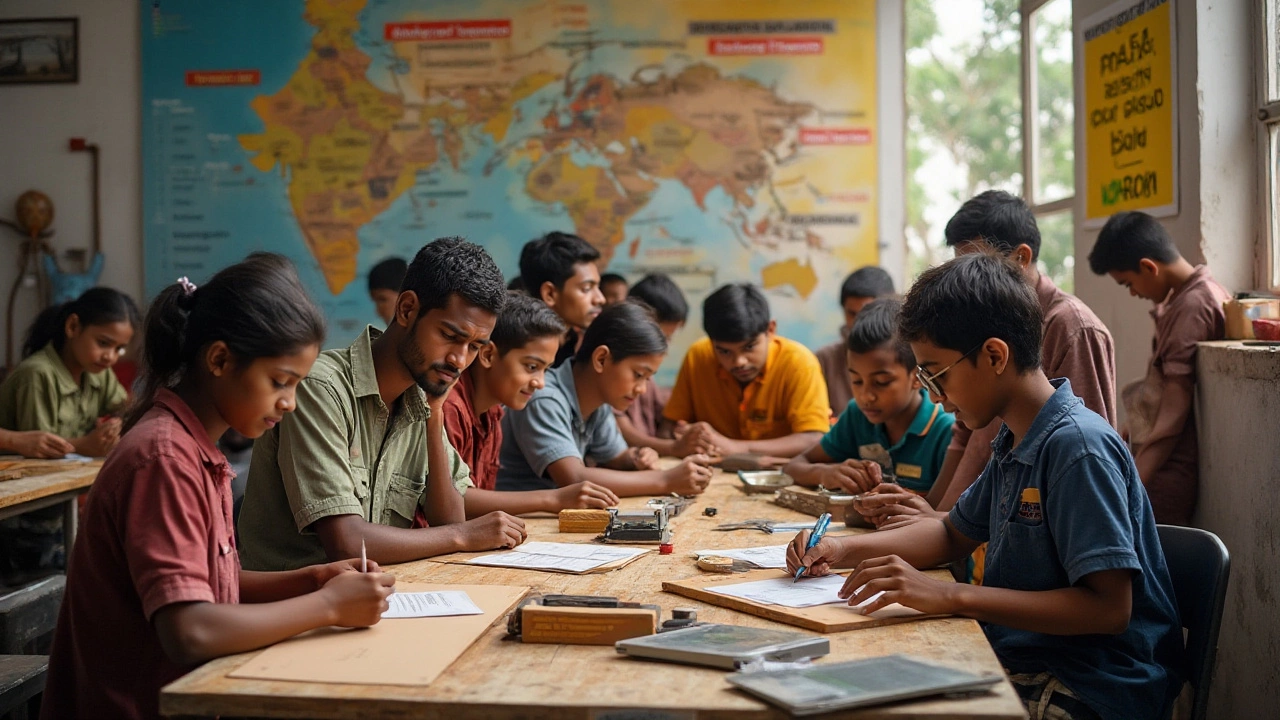
When talking about the paths to acquiring career-specific skills, the term 'vocational training' often comes to mind. But is there another word for it? This has been a growing question as educational landscapes evolve. Vocational training, while commonly used, is but one name in a diverse lexicon of skill-enhancing practices.
Governments around the world play a vital role in supporting these initiatives, which help individuals build competencies required in the labor market. It's not just about learning a trade—it's about shaping one's future in a practical way. Some might call it career education or technical training, indicating how these programs align closely with specific job roles.
By exploring these different names and their nuances, we're not only looking at labels but at diverse methodologies and approaches that support lifelong employability. Such insights can greatly assist those seeking career-focused education in an ever-changing global job market.
- Defining Vocational Training
- The Role of Government in Skill Development
- Alternative Names and Concepts
- Importance for the Workforce
- Challenges in Vocational Education
- Future Prospects and Innovations
Defining Vocational Training
Understanding what vocational training truly encompasses begins with recognizing its crucial role in the education sector. Vocational training is an educational method that prepares individuals for specific trades, crafts, and careers at various levels—from a craft or technician to engineering roles in industries such as technology, healthcare, and the arts. What sets it apart from traditional academic education is its focus on hands-on, practical experience aimed at equipping students with the skills that can be applied directly in the workforce. This training often takes place in a classroom setting, at a vocational school, or through apprenticeships that partner with established professionals in the field.
The scope of vocational training covers myriad occupations, including electricians, chefs, graphic designers, and healthcare assistants, to name just a few. In countries like Germany and Switzerland, the dual education system is a prominent model, integrating apprenticeships in industries with theoretical study at vocational schools. According to the International Labour Organization, roughly 75% of all upper-secondary students in the European Union are enrolled in vocational education programs. Such systems highlight the significance governments have placed on this practical approach to education in crafting a more adaptable and skilled workforce.
Skill development programs aim at bridging the gap between theoretical knowledge and practical application. In recent years, there has been a growing recognition of the need to modernize vocational training to adapt to technological advancements and global labor market changes. An insightful quote from the European Centre for the Development of Vocational Training says,
"Vocational education and training (VET) is not just something you do after finishing school—it is a lifelong investment in employability, career progression, and personal development."This perspective emphasizes vocational training’s continuous evolution and adaptation, which sustains its relevance in the modern job market.
It's also worth noting the different terminologies used interchangeably with vocational training, such as career and technical education (CTE) in the United States, which offers similar philosophies but may include additional academic subjects. This diversity in terminology reflects the varied approaches and acceptance of vocational training across cultures. In a world where adapting to rapid technological change is essential, vocational training provides an avenue for individuals to upgrade their skills and remain competitive. Amidst debates on the effectiveness of traditional education systems, vocational training offers a pragmatic alternative for many who thrive in practical and hands-on environments.
The relevance of vocational training in today’s dynamic job market cannot be understated. While traditional education’s emphasis on academic excellence remains valued, practical skill sets are increasingly necessary. Vocational training bridges this divide by providing pathways not just to employment but to meaningful, lifelong careers. As economies transform, expanding these opportunities becomes all the more vital. Understanding vocational training in its various forms helps us appreciate its significant contribution to both individual potential and broader economic prosperity.
The Role of Government in Skill Development
Governments worldwide have recognized that vocational training is pivotal in crafting a skilled workforce, essential for economic growth and stability. Investment in such training programs is not merely a public expenditure but a strategic initiative to enhance national productivity. State bodies, therefore, partner with educational institutions and industry leaders to create curriculums that meet labor market demands. These partnerships ensure that the programs teach relevant competencies that align with the evolving requirements of various sectors, from manufacturing to information technology.
In countries like Germany, for example, the government's dual-system of education seamlessly integrates apprenticeships with classroom learning, setting a gold standard for vocational training. This system is supported by legislation that mandates cooperation between training centers and industries. Governments also fund research to continuously adapt these programs, ensuring they remain pertinent to technological advancements and shifting economic landscapes. Vocational strategies in places like Singapore emphasize lifelong learning, setting up an ecosystem where skill development is a continual journey rather than a one-time event.
A crucial element of government involvement is providing financial aid and incentives to both trainees and the training entities. Scholarships, grants, and tax breaks are common tools to encourage enrollment and the establishment of training facilities. Government funding can significantly lower barriers, making it easier for underrepresented groups to access these opportunities. Such measures are vital in addressing skill gaps and reducing unemployment rates. As a result, countries that heavily invest in training programs often see higher employment rates and a more vibrant economic milieu.
The impact of government-led skill development doesn't just stop at economic gains. Social equity plays a central role, where initiatives are designed to reach disadvantaged communities, providing equal opportunities for all societal segments. This kind of support helps people climb the socio-economic ladder, thus influencing not only individuals but entire communities. In this context, it is important to consider the statements from thought leaders like the International Labour Organization, which emphasizes the role of training as a path to decent work and improved livelihoods.
One of the most effective ways governments measure the success of these initiatives is through data analytics. By keeping track of employment statistics, skill mismatch rates, and participant feedback, authorities can fine-tune programs. With such data-driven insights, they can allocate resources more efficiently and optimize the training landscape to better serve the nation’s needs. For instance, if a country observes a rising demand for data scientists, they can rapidly adjust their training offerings to prepare individuals effectively for such roles.
In summation, the government's role in vocational training is multifaceted, acting as a cornerstone for societal upliftment and economic prosperity. By offering continued support in education, funding, and policy-making, states ensure that their populations are not just ready for current market demands, but are agile enough to adapt to future uncertainties. Developing a skilled workforce is not a static goal but a dynamic process, one that evolves with the tides of industrial and technological progression.

Alternative Names and Concepts
When we think about vocational training, a myriad of terms might come to mind. It's not merely a matter of semantics; these terms reflect varied educational philosophies and methodologies that shape the approach to career preparation. One prominent alternative term is 'career education.' This term emphasizes the educational aspect of training, instilling a sense of progressive learning as individuals navigate their career paths. Unlike traditional school-based education, this focuses on experiential learning and practical skill development.
Another often-used term is 'technical training.' This designation focuses squarely on the hands-on, skill-specific instruction that prepares individuals directly for technical roles in industries such as engineering, IT, or healthcare. Recognizing the specificity and demanding nature of these fields, technical training programs are rigorous and aligned with industry standards. These programs often collaborate with businesses to ensure that the skills taught match current job market demands.
In various regions, the phrase 'workforce development' captures the essence of vocational training’s goal: preparing a competent workforce that can meet the challenges of today’s economy. Governments, recognizing the crucial role played by skilled labor, often spearhead such initiatives. Statistics indicate that countries with robust workforce development programs tend to have lower unemployment rates and higher levels of job satisfaction.
Some prefer the term 'skill development programs,' which highlights the process of acquiring new competencies that are in demand across various sectors. As industries rapidly evolve with technology, continuous skill development is essential for employees to remain relevant. A compelling insight from the World Economic Forum suggests that by 2030, over 40% of current job roles will demand significantly different skills. This highlights the shifting landscape, where individuals need to be proactive in their learning journeys.
The Director-General of UNESCO once noted, 'Education is not just about learning; it's about equipping individuals with the skills they need to adapt and thrive in an ever-changing world.'Such statements underscore the importance of skill development as part of vocational training's broader objectives.
The interchangeable use of these terms may sometimes lead to confusion, but understanding their specific nuances can help individuals tailor their educational pursuits to their career goals. Whether one is seeking to enter the workforce directly after training or aiming for further education, the appropriate choice of vocational training—or its alternatives—can significantly impact future career success.
Importance for the Workforce
In the context of the modern economy, vocational training holds monumental significance for the workforce. At a time when technological advancements are driving rapid changes across industries, having a well-trained workforce is vital for ensuring the efficiency and sustainability of businesses. These programs are not just about gaining specialised knowledge; they bridge the gap between theoretical education and practical application. With careers becoming multifaceted, the traditional trajectory of academic education does not always cater to the hands-on demands of certain roles in industries such as manufacturing, healthcare, and information technology.
The incorporation of skill-oriented programs acts as a catalyst for economic growth by addressing the skills gap—a persistent issue where the demands of employers do not align with the skills potential employees possess. According to a study by the European Centre for the Development of Vocational Training, the employment rate for individuals who have undergone vocational education is nearly 10% higher than their counterparts in general education. This staggering statistic highlights the success rate in reducing unemployment through targeted skill development.
Such programs offer a double-edged benefit: they empower individuals by affording them greater job security and competitive earning potential, while businesses gain competent personnel who can hit the ground running. Businesses, especially small and medium enterprises, often rely heavily on a skilled workforce. They harness these programs to foster innovation and maintain competitiveness in a global market. Moreover, through vocational education, employees can also anticipate career advancement, adding value to their professional repertoire and opening pathways to higher roles.
The importance of vocational training cannot be underestimated when we view it from a broader societal and economic perspective. It acts as a tool for social inclusion, offering a path to secure employment for those who might otherwise struggle to gain a foothold in the job market. It can be particularly transformative for disadvantaged or marginalised communities, providing the skills necessary for sustainable employment. As highlighted by Johann N. Schneider-Ammann, former President of the Swiss Confederation, who once noted,
"Vocational education and training provide an exceptionally effective tool for adapting to changes in the labor market, and for reducing unemployment among young people."
As economies continue to grow and diversify, the need for specific trades rises, underscoring the importance of aligning vocational programs with industry needs. Policymakers and educational authorities must work collaboratively to design curricula that reflect current and future workforce requirements. By doing so, they ensure the seamless integration of graduates into employment roles that match their skills and enthusiasm, resulting in a more vibrant and robust economy. Ultimately, vocational training is not just about filling jobs; it’s about creating a dynamic workforce that thrives on continuous learning and adaptation.

Challenges in Vocational Education
Upon delving into the realm of vocational training, it's clear that while these programs offer significant advantages for skill acquisition, they are not devoid of challenges. One of the most pressing issues these education models face is the rapid evolution of technology and industries. As job requirements change frequently, maintaining a curriculum that remains pertinent and effective can become a daunting task. Schools and training facilities must continuously update their resources and teaching methodologies to avoid obsolescence, which demands a significant input of both time and capital.
Financial constraints serve as another substantial hurdle. Many vocational institutions operate with limited funding, which affects not only the quality of education offered but also the accessibility of these programs to aspirants. A lack of adequate funding may lead to compromised infrastructure, shortage of trained personnel, and insufficient availability of hands-on equipment—all of which are crucial for effective skill development. While governments often extend support, ensuring sustained and substantial financial resources remains a significant challenge that policymakers need to address.
Public perception also plays a decisive role in shaping the success of vocational education. There is sometimes a stigma attached to vocational tracks as being less prestigious compared to traditional academic routes. This societal perception can lead to reduced enrolment and participation, further widening the skill gap in industries that rely heavily on technical expertise. Efforts to change this narrative are underway, yet transforming deep-seated beliefs can take time and consistent advocacy.
The integration of technology, while a potential enabler, also presents its own set of challenges. With the advent of automation and AI, some argue that certain trades might face reduced demand. A delicate balance is required to train individuals in skills that are technologically relevant yet resilient to automation risks. As Ray Marshall, the former U.S. Secretary of Labor, wisely stated,
'Vocational training must always look forward, tying itself to the pulse of industry and societal needs.'His words underscore the dynamic nature of this educational arena and the importance of foresight.
Addressing these challenges entails a multifaceted approach where stakeholders—including governments, industries, and educational institutions—collaborate to create well-rounded and adaptable programs. Emphasizing continuous learning and flexibility can ensure that individuals not only find employment but also enjoy sustained career growth. The resilience of vocational training lies in its ability to evolve and break free from traditional molds, ultimately ensuring its relevance in an ever-shifting employment landscape.
Future Prospects and Innovations
As we stride into the future, the landscape of vocational training and skill development continues to evolve in significant ways. The integration of technology is reshaping how we think about career education. For instance, virtual reality (VR) and augmented reality (AR) are bringing new dimensions to hands-on training, enabling trainees to practice in simulated, yet highly realistic, environments. This allows for mistakes to become learning opportunities without the real-world repercussions, greatly enhancing the safety and effectiveness of the training process.
The impact of AI and machine learning cannot be understated either, as these technologies facilitate personalized learning experiences. By analyzing learning patterns and progress, AI systems can tailor educational content to meet the unique needs of each learner, enabling better engagement and improved outcomes. This trend towards individualized learning is reflected in platforms that offer skills-based learning journeys, often heralded as a revolutionary shift in how education is delivered. In many ways, these technological advancements are democratizing access to education, providing opportunities to those who might not traditionally have them.
Another promising innovation lies in the modularization of skill training programs. This approach allows individuals to pursue shorter, specific courses that equip them with micro-credentials. These are often recognized across industries and geographies, making qualifications more portable and flexible compared to traditional degrees. Companies are increasingly valuing such targeted learning as they adapt to a rapidly changing workforce. Reports suggest that over 70% of global companies view continuous learning as an essential component of their long-term strategy for employee development.
Online platforms, like Coursera and edX, are expanding their offerings to include these skill development programs as part of their catalogues, making them accessible worldwide. According to a recent study, enrollment in vocational courses on such platforms rose by 30% in the past two years alone. This shift indicates a broader acceptance of non-traditional learning routes that hold the potential to outpace the rigidity of conventional educational systems. As the conversation around education evolves, it's crucial to highlight innovative partnerships between governments and private sectors that aim to bridge skill gaps in the workforce. Collaborative efforts have seen the rise of boot camps and apprenticeships, aligning curriculum with real-world job requirements more precisely than ever before.
"The future of work requires a pivot towards skills and continuous learning," notes Lisa Greenbaum, an educational technology analyst at Forrester Research. "We are witnessing a seismic shift in how people approach their professional development."
This evolving landscape is paving the way for new economic opportunities and pathways previously unexplored. Innovations in vocational training are not just technological—they're cultural, economic, and practical revolutions that could redefine what education looks like in the 21st century. For governments, staying ahead of this curve is critical, not just in terms of policy but in fostering environments where these innovative educational models can thrive and benefit society as a whole.

